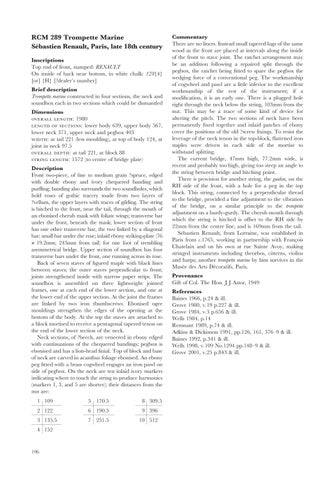50731-193-198
3/4/07
14:52
Page 196
RCM 289 Trompette Marine Sébastien Renault, Paris, late 18th century Inscriptions Top end of front, stamped: RENAULT On inside of back near bottom, in white chalk: 128{4} [or] {H} [?dealer’s number] Brief description Trompette marine constructed in four sections, the neck and soundbox each in two sections which could be dismantled Dimensions : 1980 : lower body 639, upper body 567, lower neck 371, upper neck and pegbox 403 : at tail 221 (less moulding), at top of body 124, at joint in neck 97.5 : at tail 221, at block 88 : 1572 (to centre of bridge plate) Description Front two-piece, of fine to medium grain ?spruce, edged with double ebony and ivory chequered banding and purfling; banding also surrounds the two soundholes, which hold roses of gothic tracery made from two layers of ?vellum, the upper layers with traces of gilding. The string is hitched to the front, near the tail, through the mouth of an ebonised cherub mask with foliate wings; transverse bar under the front, beneath the mask; lower section of front has one other transverse bar, the two linked by a diagonal bar; small bar under the rose; inlaid ebony striking-plate (76 × 19.2mm; 243mm from tail) for one foot of trembling asymmetrical bridge. Upper section of soundbox has four transverse bars under the front, one running across its rose. Back of seven staves of figured maple with black lines between staves; the outer staves perpendicular to front; joints strengthened inside with narrow paper strips. The soundbox is assembled on three lightweight jointed frames, one at each end of the lower section, and one at the lower end of the upper section. At the joint the frames are linked by two iron thumbscrews. Ebonised ogee mouldings strengthen the edges of the opening at the bottom of the body. At the top the staves are attached to a block mortised to receive a pentagonal tapered tenon on the end of the lower section of the neck. Neck sections, of ?beech, are veneered in ebony edged with continuations of the chequered bandings; pegbox is ebonised and has a lion-head finial. Top of block and base of neck are carved in acanthus foliage ebonised. An ebony peg fitted with a brass cogwheel engages an iron pawl on side of pegbox. On the neck are ten inlaid ivory markers indicating where to touch the string to produce harmonics (markers 1, 3, and 5 are shorter); their distances from the nut are: 1 109
5 170.5
8 309.5
2 122
6 190.5
9 396
3 135.5
7 251.5
10 512
4 152
196
Commentary There are no liners. Instead small tapered lugs of the same wood as the front are placed at intervals along the inside of the front to stave joint. The ratchet arrangement may be an addition following a repaired split through the pegbox, the ratchet being fitted to spare the pegbox the wedging force of a conventional peg. The workmanship of cogwheel and pawl are a little inferior to the excellent workmanship of the rest of the instrument; if a modification, it is an early one. There is a plugged hole right through the neck below the string, 103mm from the nut. This may be a trace of some kind of device for altering the pitch. The two sections of neck have been permanently fixed together and inlaid patches of ebony cover the positions of the old ?screw fixings. To resist the leverage of the neck tenon in the top-block, flattened iron staples were driven in each side of the mortise to withstand splitting. The current bridge, 47mm high, 77.2mm wide, is recent and probably too high, giving too steep an angle to the string between bridge and hitching point. There is provision for another string, the guidon, on the RH side of the front, with a hole for a peg in the top block. This string, connected by a perpendicular thread to the bridge, provided a fine adjustment to the vibration of the bridge, on a similar principle to the trompette adjustment on a hurdy-gurdy. The cherub mouth through which the string is hitched is offset to the RH side by 22mm from the centre line, and is 169mm from the tail. Sébastien Renault, from Lorraine, was established in Paris from c.1765, working in partnership with François Chatelain and on his own at rue Sainte Avoy, making stringed instruments including theorbos, citterns, violins and harps; another trompette marine by him survives in the Musée des Arts Décoratifs, Paris. Provenance Gift of Col. The Hon. J J Astor, 1949 References Baines 1966, p.24 & ill. Grove 1980, v.19 p.227 & ill. Grove 1984, v.3 p.656 & ill. Wells 1984, p.14 Remnant 1989, p.74 & ill. Adkins & Dickinson 1991, pp.126, 161, 376–9 & ill. Baines 1992, p.341 & ill. Wells 1998, v.109 No.1294 pp.148–9 & ill. Grove 2001, v.25 p.843 & ill.
